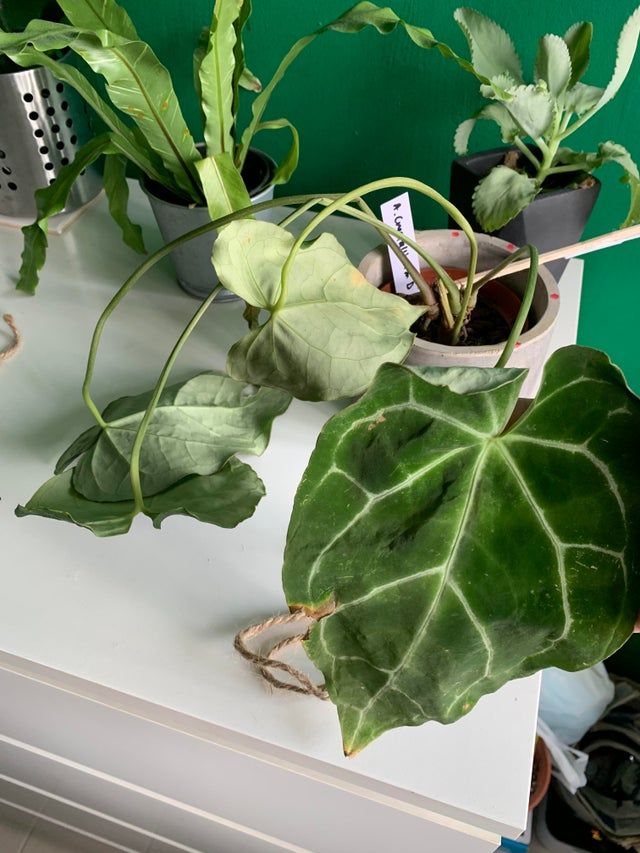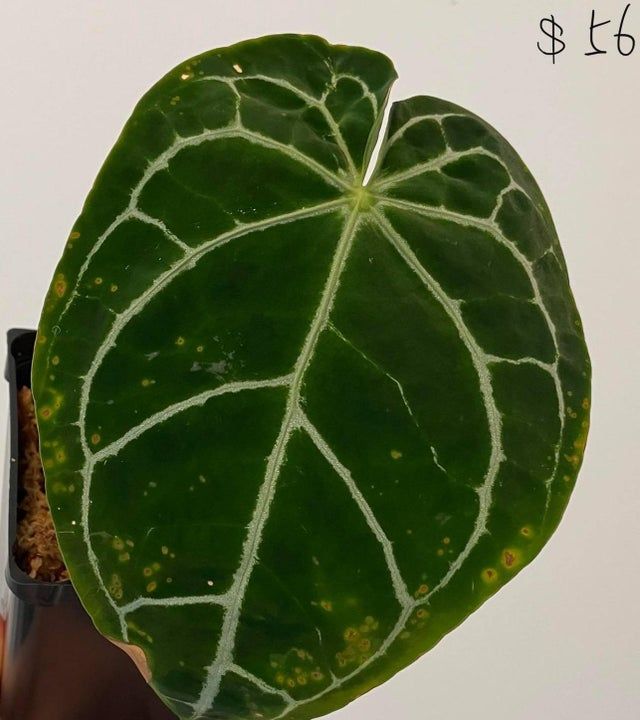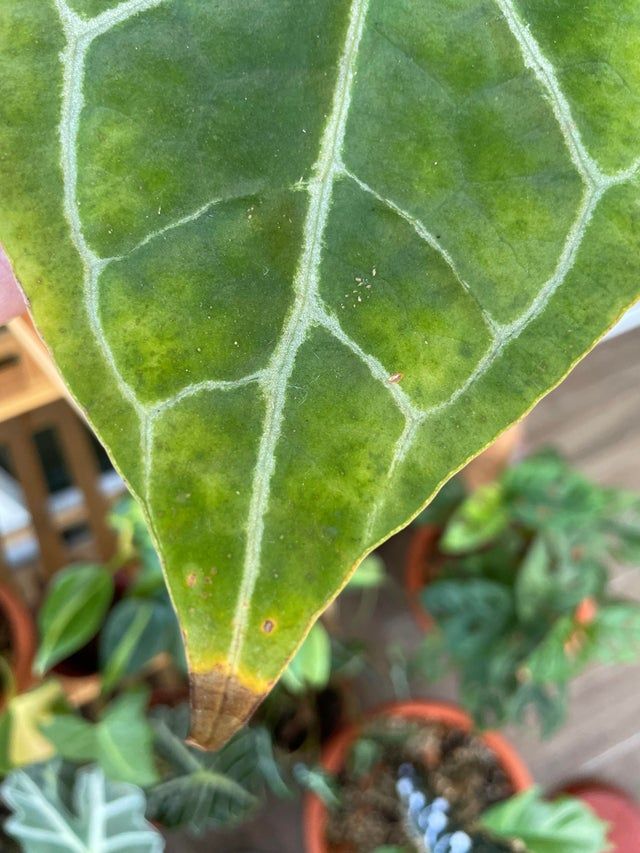Anthurium Crystallinum - Dealing with Diseases and Pests
Root rot and fungal infections are the greatest risks to watch out for. Their thick leaves does not attract chewing pests (too much work) but they are more likely to be attacked by sucking insects that feed on plant sap.

Don’t let that breathtaking foliage intimidate you—caring for Anthurium Crystallinum is straightforward with a little know-how and a lot of dedication.
Like its other tropical cousins, staying on top of watering, humidity, and light will ensure that your crystallinum is vibrant and healthy.
Anthurium Crystallinum are epiphytes, this means that they can attach themselves to other plants/objects and grow that way. A pretty cool look too!
Because of this adaptation, they have specially evolved aerial roots that can be pretty delicate, so when watering your crystallinum, pay attention to drainage.
Root rot and fungal infections are the greatest risks to watch out for. Their thick leaves does not attract chewing pests (too much work) but they are more likely to be attacked by sucking insects that feed on plant sap.
Below are some of the most common pests and diseases that can attack your Cystallinum plants.
What diseases and pests do Anthurium Crystallinum suffer from?
As highlighted earlier, the Anthurium Crystallinum is resistant to most pests and won’t often attract them. However, if your other plants carry pests, they’ll likely transfer them to your Anthurium.
And these pests suck. Literally and figuratively.
Aphids, spider mites and mealybugs can all badly affect your crystallinum by sucking their sap to feed on crucial plant nutrients. They’ll also secrete a sticky substance called ‘honeydew,’ which tempts other insects to come and have a go. It’s not nearly as pleasant as it sounds.
As for diseases, in Anthurium, they’re almost always caused by overwatering. The biggest to watch out for are fungal diseases, bacterial diseases, and root rot. Fungal infections are caused by overwatering and over-dampness in the soil and on the plant itself. Root rot occurs when your plant is left in standing water.

How do you spot signs of pests and diseases in Anthurium Crystallinum?
Yellowing leaves, drooping and lesions are common signs that something isn’t quite right with your Anthurium Crystallinum. Leaf discoloration is often the first physical manifestation of any issues. As soon as you notice it, give your plant a thorough examination.
Always shoot for the root of the problem. Work from the bottom up by first having a peek at your crystallinum’s root structure. If they’re solid, defined and free of any mush, great. If the roots look like wet tissue paper and are mushy to the touch, you likely have root rot. Overwatering is almost always the primary cause. This might be a drainage issue or overzealous watering.
Bacterial blight comes next, and it’s as nasty as it sounds. It’s one of the most common bacterial diseases in Anthurium Crystallinum, and it looks the part. Yellow, water-soaked lesions beginning to form along the leaf margins of your plant are a sure sign of this disease. This can spread quickly, as bacteria are adept at swimming across wet surfaces. Make sure to keep your foliage dry.
Although rare for this plant, pests leave little clues for you to pick up once they move in. Tell-tale webbing gives away Spider mites. Dark brown discolouration and small yellowing areas hints at thrips. And tiny green, black or gray bugs scurrying about on the stems of your plant shows aphid activity.
How do you treat Anthurium Crystallinum for pests and diseases?
You probably need no telling how important preventing diseases instead of trying to cure them is. We've all had an almost 2-year lesson on that.
Part of your regular care for Anthurium Crystallinum will mean getting up close and personal to water and feed your plant. Take this as an opportunity to have a little nosy and see if anything looks out of place.
Pests usually only appear on your crystallinum as a result of other plants carrying them. Many plant enthusiasts quarantine new plants for around two weeks before letting them loose with the rest of their collection. While we can't stand to think of quarantine or isolation for one minute longer, we doubt your plants will mind too much.
If you're forced to take action, there are natural remedies you can try first. Rosemary oil diluted in distilled water can help kill off pests when sprayed onto the leaves of your crystallinum. Let the solution sit for about 20 minutes, then gently wash it off with lukewarm water. Other oils like neem oil can also be effective. However, the velvety leaves of your crystallinum won't like oil being applied directly to them. In this case, dab a little bit around the base of the plant to deter any pests.
As for diseases, there's only one thing to remember—don't overwater! Get your drainage right, and always check soil dampness before watering. If it’s too late and infection has set in, remove the infected area.
FAQs for Anthurium Crystallinum
While Anthuriums tend to be straightforward, the Anthurium Crystallinum can be fussier than other species. Usually, it's those gorgeous leaves that show there's a problem.
Yellow spots on my Anthurium Crystallinum?

Too much of a good thing. Tropical plants like Anthurium love it wet, but overwatering will harm them. Yellow leaves are usually the first sign, so only water the plant when the top 2-3 inches of soil feel dry. Too much direct light exposure could also be a factor, so try to keep your plant out of those rays.
Why are there brown leaves and dead ends on my Anthurium Crystallinum?

Not enough of a good thing. Low indoor air humidity is the leading cause, and the brown tips and leaves are an indication your plant is fighting for its life. If your room lacks humidity, there are helpful tips above you can follow. You should also increase the frequency of watering.
Why are the leaves on my Anthurium Crystallinum wilting?

With wilting, look to the roots. You'll usually see some signs of leaf discolouration, too (slight yellowing). Depending on the state of the roots, you can likely determine the problem is over or under-watering. If the roots are brown and mushy, you have root rot.